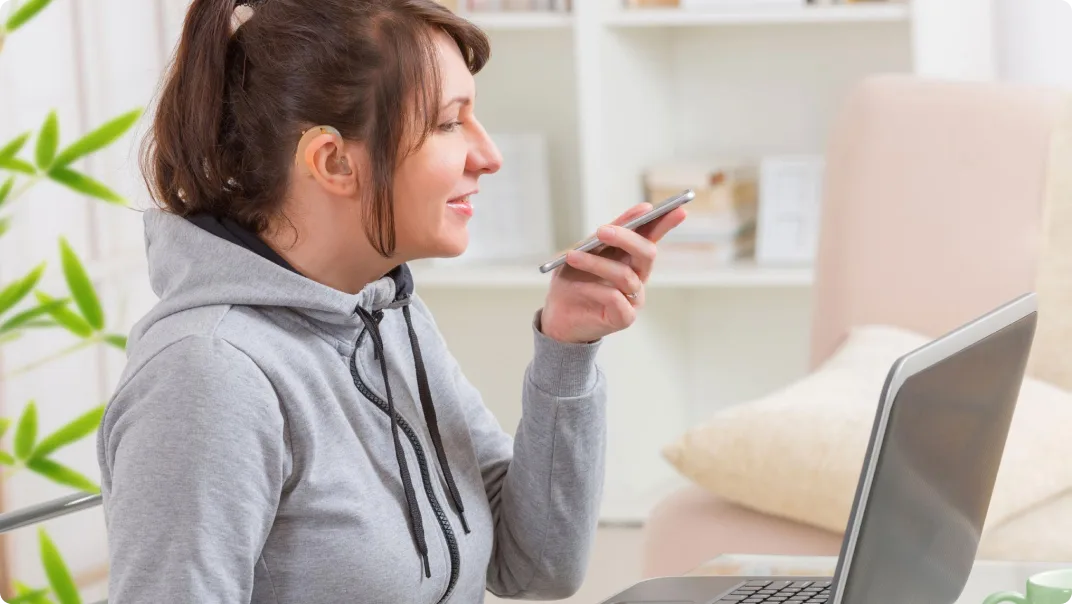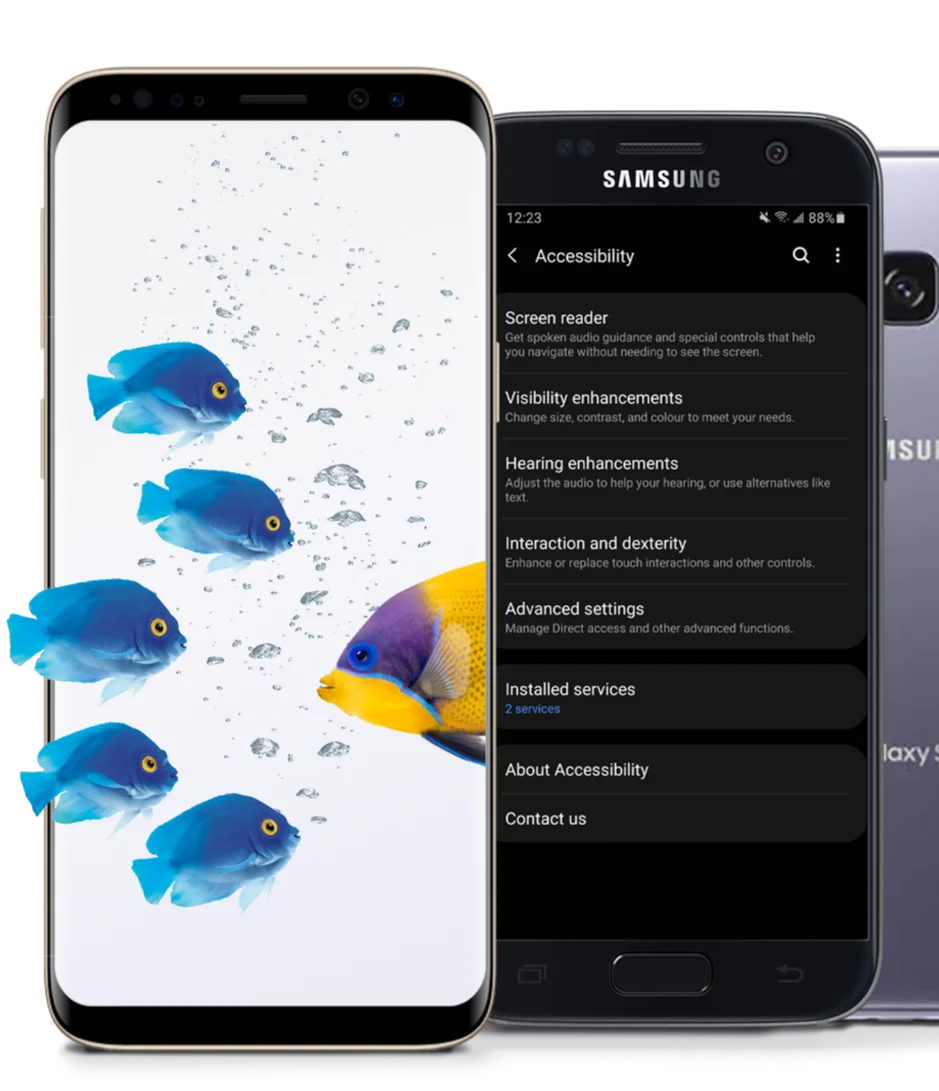Mobile phones built with accessibility in mind
Many mobile phones come with built-in and often very advanced features that can make them easier to use for people with disabilities. Explore our smartphone catalogue for the full range of accessible features and devices.


Vision
Choose from a variety of accessibility features designed to help persons with low or no vision.

Mobility and dexterity
Mobility and dexterity features provide options to operate your phone based on your individual needs.

Learning, remembering & reading
Find features that let you set reminders, speed up communication and control your phone in a variety of ways.

Hearing and speech
Learn about features such as teletypewriter (TTY) support, video communication, or hearing aid compatibility.
Visual accessibility features
Visual accessibility smartphone features are designed to help the blind or visually impaired stay connected. Many can be adjusted to solve very specific vision challenges.

Magnify your screen
See everything up close on your phone’s screen by magnifying all of the visible content.
Voice-activated controls
Tell your phone to call a friend, send a message, find information for you, schedule meetings and much more.
Raised keypad markers
Raised tactile markers on specific keys keep your fingers oriented on the phone’s keypad so you can be confident you’re always pressing the right key.
Choice of font and screen sizes
You can also change the font size for text messaging on some devices and choose a phone with a larger screen.
Built-in screen reader
Phones with a built-in screen reader announce what is displayed on the screen for you, making two-way communication much easier.
External braille display
Access your phone's features using an external braille display connected to your phone and let your fingers do the talking.
Adjustable screen displays
If brightness levels or certain colours impact your ability to read what’s on your phone screen, you can adjust the brightness and contrast to make text and images clearer. Invert colours, for example try changing from white font on black background to black font on white background to test what works best for your vision needs.
Speech-to-text
Use speech-to-text functionality to remove the need to type as you dictate emails, text messages and search for information using your phone.
Audible or tactile feedback
Audible or tactile feedback, such as vibration, triggered by your actions replaces visual confirmation to help you feel confident you are doing what you want to do.
Mobility accessibility features
Built-in accessibility features and add-ons help people with mobility, motor or other physical challenges use their smartphones more easily.

Durable and accessible designs
Some phones are more rugged than others, designed to withstand frequent bumps and drops. Even the shape of your phone can make a difference. “Candy bar phones” are rectangular, candy bar-shaped phones that are especially easy to hold. Clam shell or flip phones can flip open and answer calls automatically, making them especially useful for customers who are blind or have limited vision. Touchscreen smartphones typically have larger screens that can make texting and communicating through video calls much easier.
Operate the phone through other devices
An external keyboard lets you access features, settings and text-messaging, and an external mouse can be used instead of a phone’s touchscreen interface. Some phones enable a stylus or pointing device to also be used to operate the phone's touch screen and buttons. Other connectable input devices include joysticks or Bluetooth braille display.
Physical keypads
A physical number pad, also known as a 123 dial pad, has 3 columns and 4 rows that let you type numbers and letters. It is built into the phone, unlike a touch dial pad that appears on screen when you want to make a call. It’s a much more tactile way of operating a phone.
Answer calls automatically
An auto-answer feature enables you to set your phone to answer all calls automatically. It can answer various types of calls, including regular calls and Facetime video and voice calls.
External input device
Smartphones that support an alternate input device or switch access allows you to operate and control your phone from an external device.
Built-in screen reader
Phones with a built-in screen reader read out what is displayed on the screen for you, making two-way communication much easier.
Keypad shortcuts
Most phones let you do everything faster by setting your own shortcuts, such as abbreviated words for common words or phrases you use, so you don’t have to type each character.
Hands-free headset
Hands-free Bluetooth technology lets you use a wireless headset or earbuds to make and answer calls.
Cognitive accessibility features
A cognitive disability can make it more difficult to perform certain tasks, such as remembering phone numbers or navigating an unfamiliar phone. Some phones have features that are particularly helpful for people with cognitive needs.

Physical keypads
A physical number pad, also known as a 123 dial pad, has 3 columns and 4 rows that let you type numbers and letters. It is built into the phone, unlike a touch dial pad that appears on screen when you want to make a call. It’s a much more tactile way of operating a phone.
Choice of call alerts
Set up alert options which include audio, visual, or vibrating, to notify you of an incoming call, text message, or email.
Photo contacts list
If you find it easier to recognize faces than numbers, you can attach photos of your friends, family and other contacts with their telephone number to help you keep in touch.
Familiar keypad layout
Phones with a physical keypad (raised keys instead of a touch screen) that matches a full QWERTY computer keyboard is helpful for persons who find it easier to use a physical keypad in place of a touch screen.
Audible or tactile feedback
Audible or tactile feedback, such as vibration, triggered by your actions replaces visual confirmation to help you feel confident you are doing what you want to do.
Easy-to-use devices
Some phones are designed with or have options enabled in the settings, to be especially simple to use with keys and a display that are easy to operate and see.
Keypad shortcuts
Most phones let you do everything faster by setting your own shortcuts, such as abbreviated words for common words or phrases you use, so you don’t have to type each character.
Built-in screen reader
Phones with a built-in screen reader read out what is displayed on the screen for you, making two-way communication much easier.
Hearing/speech accessibility features
Phones that work seamlessly with the assistive devices or software you already use can make a huge difference to how you communicate.

Hearing aid compatibility
Some hearing aid compatible (HAC) cellular phones will work with hearing aids that support the telephone switch (T-switch) feature. A T-switch is built into hearing aids with a telecoil, a small wire that acts as an antenna, to enable the user to switch it on and off.
HAC phones have M- and T-ratings. The M-rating shows how well the mobile phone works with a hearing aid in microphone mode. The T-rating shows how it works in telecoil mode. Phones that support a T-switch must have an M- or T-rating of 3 or 4.
Alternative and augmentative communication (AAC) support
Alternative and Augmentative Communication (AAC) software is used to supplement or replace speech or writing for individuals with communication disabilities. Many phones support AAC Apps found in App Stores.
Note: Phones may contain features and apps that don’t work with AAC.
Teletypewriter support
A teletypewriter (TTY) is a keyboard operated device that lets someone type a message and send it electronically to a phone or other device with a screen that lets the recipient read it and respond. It is widely used by persons who are deaf or hard of hearing. A wireless phone that supports TTY mode is able to be connected to a cellular-compatible TTY.
Video calling and messaging
Advances in mobile video technology, such as Facetime, Google Hangouts and Skype, means that many phones support two-way audio and visual communication via video. This allows people whose first language is sign language, to more easily communicate.




